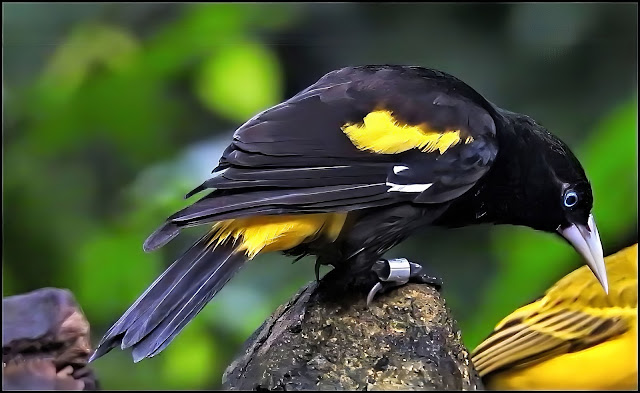The wood duck or Carolina duck (Aix sponsa) is a species of perching duck found in North America. The drake wood duck is one of the most colorful North American waterfowls.
The wood duck is a medium-sized perching duck. A typical adult is from 47 to 54 cm (19 to 21 in) in length with a wingspan of between 66 and 73 cm (26 and 29 in). The wood duck's weight ranges from 454–862 grams (16.0–30.4 oz). This is about three-quarters the length of an adult mallard. It shares its genus with the Asian mandarin duck (Aix galericulata).
The adult male has stunning multicolored iridescent plumage and red eyes, with a distinctive white flare down the neck. The female, less colorful, has a white eye-ring and a whitish throat. Both adults have crested heads. The speculum is iridescent blue-green with a white border on the trailing edge.
The male's call is a rising whistle, jeeeeee; the females utter a drawn-out, rising squeal, do weep do weep, when flushed, and a sharp cr-r-ek, cr-e-ek for an alarm call.
Their breeding habitat is wooded swamps, shallow lakes, marshes, ponds and creeks in the eastern United States, the west coast of the United States, some adjacent parts of southern Canada, and the west coast of Mexico. They usually nest in cavities in trees close to water, although they will take advantage of nesting boxes in wetland locations. Other species may compete with them for nesting cavities, such as birds of prey, as well as mammals such as grey squirrels, and these animals may also occupy nest boxes meant for wood ducks. Wood ducks may end up nesting up to a mile away from their water source as a result. Females line their nests with feathers and other soft materials, and the elevation provides some protection from predators. Unlike most other ducks, the wood duck has sharp claws for perching in trees and can, in southern regions, produce two broods in a single season—the only North American duck that can do so.
Females typically lay seven to fifteen eggs which incubate for an average of thirty days. However, if nesting boxes are placed too close together, females may lay eggs in the nests of their neighbours, which may lead to nests with thirty eggs or more and unsuccessful incubation—a behaviour known as "nest dumping".
The day after they hatch, the precocial ducklings climb to the opening of the nest cavity and jump down from the nest tree to the ground. The mother calls them to her and guides them to water. The ducklings can swim and find their own food by this time. Wood ducks prefer nesting over water so the young have a soft landing.
Wood ducks feed by dabbling (feeding from the surface rather than diving underwater) or grazing on land. They mainly eat berries, acorns, and seeds, but also insects, making them omnivores. They are able to crush acorns after swallowing them within their gizzard.


%2030.jpg)






%2010.jpg)
%2012.jpg)
%2011.jpg)
%2010.jpg)




%2010.jpg)





%2010.jpg)
%2011.jpg)
%2012.jpg)



%20(Anas%20platyrhynchos)%2020.jpg)
%2020.jpg)
%2021.jpg)
%2022.jpg)
%2020.jpg)
%2020.jpg)
%2022.jpg)
%2010.jpg)

%20(Phoenicurus%20ochruros)%2020.jpg)

%2010.jpg)